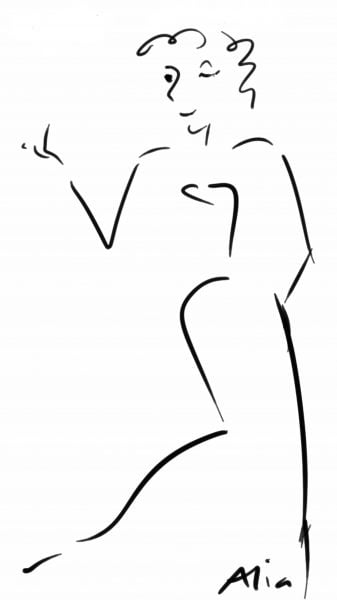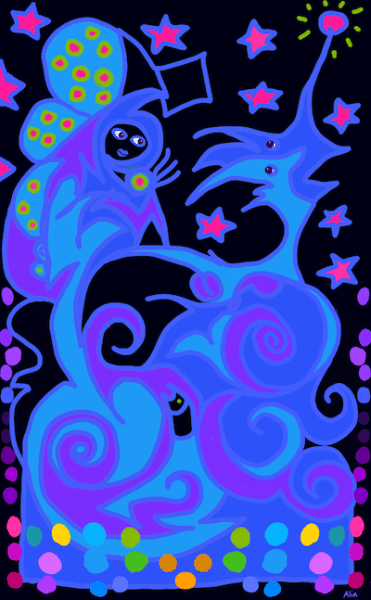How I learned to Improvise Part II
Dave Chapelle thought all the standup comics he saw just made up their stuff on stage—that they improvised. So that’s what he did, too. Yeah, he went out there and made stuff up, on the spot (his record is over 6 hours of straight improv).
Chapelle had no idea that most of the comics scripted and honed their material over weeks and months, often delivering the same show night after night in different venues. Impressive, huh?
It was the same way for me and dance. For one thing, I grew up in NYC during the 60s and 70s. The music scene was bursting with creativity and the great jam bands were very much an influence. The highly constructed, heavily produced music that we have today was unknown at the time.
These guys played all night—we left the Fillmore and the sun was coming up. Likewise in jazz and every other kind of popular music. We saw everyone, from Sun Ra and Pharaoh Sanders to Big Mama Thornton and Captain Beefheart, plus the Grateful Dead and the Allman Brothers, with Frank Zappa and Miles Davis for good measure. (We had great drugs, too—but don’t tell anyone). All this music begged for movement. It was a wild and crazy time!
I saw Zappa’s ensemble improvise an entire piece from a comic book. Yes, the musicians all had the comic book on their music stands. We, the audience, even had a role to play—we made some of the big sound effects—KA-RUNCH! Zappa conducted the comic book, and signaled us when it was our turn. (To see this show, I missed a high school band concert in which I was supposed to play. My band teacher never forgave me and later refused to write me a college recommendation. I still don’t regret it.)
Graffiti was reaching the heights of art. Catching a subway in the morning with a freshly-painted masterwork exhilarated all who experienced it. So much was going on everywhere.
So, to me, great art was improvised. When I started in Oriental dance, it was improvised as well. I had no dance training before I began belly dance, so I had no habits of choreography to unlearn. I remember hearing the ballet dancers in Bobby’s classes talking about how hard it was to relax the glutes. Not for me. I was 16 and tabula rasa.
Back in the day, there was a lot of live music in Oriental dance as well. And yes, all of it was improvised. There were songs, and they had a structure, but the musicians played what they felt. Heterophony (the musician’s license to ornament the notes and play around the melody) was in full force. Simple songs became elegant masterworks of ensemble feeling. Polyglot immigrant musicians drenched themselves in their love of their homelands, playing music together and celebrating this love with their audiences—and the lucky dancers who performed with them.
So this is where I come from, in the dance and the music. This is what has shaped my understanding. This is why I can do what I do—let the music in through my ears and transform it into movement with my body.
But it’s not the only reason. With live music I was great, but recorded music was another matter. I knew the zone existed, but with recorded music, I couldn’t reach it consistently. I did pretty well, but it was frustrating to so often feel locked in my thoughts and unable to meld with the music. And we have so much recorded music. It’s not the same thing at all. The brilliant process of discovery and collaboration the informs live music is dead and gone by the time it’s recorded.
Or is it? Like Dave, after a while, I needed more.
Finding Dunya and Dancemeditation™ made all the difference in the world. Through Dunya’s Sufi practices, such as breathing in time with the music, I learned to open the door to the zone much more easily and consistently. Awareness of breath and an ability to go inside and find my space revolutionized my dance.
And there is even more.
Tarab, according to Dr AJ Racy (a brilliant teacher, musician, and composer), is captured in recordings. It is still there. Maybe not as strong as during the live performance, and maybe not as intuitive on 34th hearing, but it is there. And this is what we have to do: Find music that speaks to us. Music that has soul, that continues to give us that love. Even if we know every note, we can still regain the feeling of grace the music contains. If it doesn’t move us, we don’t move to it. Look for heterophony. A lot of bands do not understand this principle. The music is empty. There is nothing but the melody—no ornamentation, no richness of interpretation and artistic feeling.
Favor the rich, nuanced, soul-filled songs and you will dance better, and enjoy it more.
Learn to find the zone. It is always there, and you can go there, even to recorded music.
Welcome to the joy!
Love,
Alia



No comment yet, add your voice below!